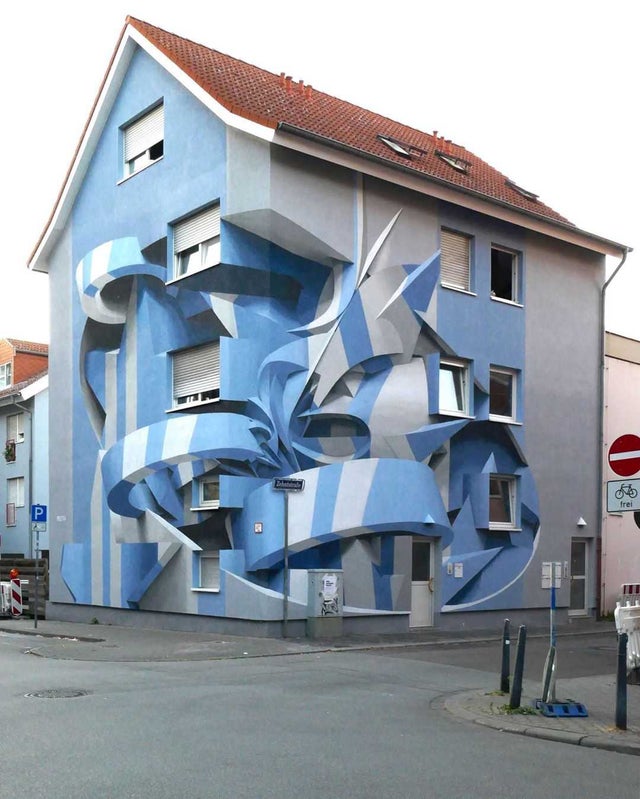Art
Tribute

Hans Holbein’s 1533 painting The Ambassadors famously contains the distorted image of a skull — it resolves into its proper shape when viewed from the correct angle.
South African artist Jonty Hurwitz created the three-dimensional homage below. “Hans Holbein the Younger is thought to be one of the fathers of Anamorphic Art. This sculpture is my tribute to his genius and inventiveness. It is an expression of gratitude for the influence he has had on my life.”
Attention to Detail
English artist Richard Dadd had established himself as a painter of fairies and other supernatural subjects when in August 1843 he became convinced that his father was the devil in disguise and killed him with a knife. In the Bethlem psychiatric hospital he was encouraged to continue painting, and when the head steward requested a fairy painting Dadd spent nine years investing The Fairy Feller’s Master-Stroke with minute detail, using a layering technique to create a three-dimensional effect.
He wrote a long poem in which he names and gives a purpose to each character. The painting is now in the Tate Britain collection.
Dadd painted many striking images — the portrait below of one of his doctors, Alexander Morison, hangs in the Scottish National Portrait Gallery.

Memorial

The gravestone of urban planner Ildefons Cerdà has a unique design: It commemorates the Eixample, the distinctive “extension” of Barcelona that Cerdà designed in the 19th century.
The Nightingale Monument

Elizabeth Nightingale died of shock at a violent stroke of lightning following the premature birth of her daughter in 1731. In his will, her son ordered the erection of this monument, which was created by Louis Francois Roubiliac and stands in Westminster Abbey. Elizabeth is supported by her husband, who tries in horror to ward off the stroke of death. Washington Irving called it “among the most renowned achievements of modern art.”
The Abbey’s website says, “The idea for this image may have come from a dream that Elizabeth’s brother in law (the Earl of Huntingdon) had experienced when a skeleton had appeared at the foot of his bed, which then crept up under the bedclothes between husband and wife. … It is said that one night a robber broke into the Church but was so horrified at seeing the figure of Death in the moonlight that he dropped his crowbar and fled in terror. The crowbar was displayed for many years beside the monument but it no longer remains.”
Progress
“Wherever there is a phonograph the musical instrument is displaced. The time is coming when no one will be ready to submit himself to the ennobling discipline of learning music. Everyone will have their ready-made or ready-pirated music in their cupboards.”
— John Philip Sousa, New York Morning Telegraph, June 12, 1906
Trompe L’Oeil

Venice-based graffiti artist Manuel Di Rita, known as Peeta, created this eye-fooling mural in Mannheim in 2019.
In a Word
philobiblist
n. a lover of books
Created by Slovakian artist Matej Kren, the Idiom Installation in Prague’s municipal library seems to present an infinite tower of books, thanks to some conveniently placed mirrors.
It debuted at the São Paulo International Biennial in 1995 and moved permanently Prague in 1998.
Art and Commerce
Before the 19th century, containers did not come in standard sizes, and students in the 1400s were taught to “gauge” their capacity as part of their standard mathematical education:
There is a barrel, each of its ends being 2 bracci in diameter; the diameter at its bung is 2 1/4 bracci and halfway between bung and end it is 2 2/9 bracci. The barrel is 2 bracci long. What is its cubic measure?
This is like a pair of truncated cones. Square the diameter at the ends: 2 × 2 = 4. Then square the median diameter 2 2/9 × 2 2/9 = 4 76/81. Add them together: 8 76/81. Multiply 2 × 2 2/9 = 4 4/9. Add this to 8 76/81 = 13 31/81. Divide by 3 = 4 112/243 … Now square 2 1/4 = 2 1/4 × 2 1/4 = 5 1/16. Add it to the square of the median diameter: 5 5/16 + 4 76/81 = 10 1/129. Multiply 2 2/9 × 2 1/4 = 5. Add this to the previous sum: 15 1/129. Divide by 3: 5 1/3888. Add it to the first result: 4 112/243 + 5 1/3888 = 9 1792/3888. Multiply this by 11 and then divide by 14 [i.e. multiply by π/4]: the final result is 7 23600/54432. This is the cubic measure of the barrel.
Interestingly, this practice informed the art of the time — this exercise is from a mathematical handbook for merchants by Piero della Francesca, the Renaissance painter. Because many artists had attended the same lay schools as business people, they could invoke the same mathematical training in their work, and visual references that recalled these skills became a way to appeal to an educated audience. “The literate public had these same geometrical skills to look at pictures with,” writes art historian Michael Baxandall. “It was a medium in which they were equipped to make discriminations, and the painters knew this.”
(Michael Baxandall, Painting and Experience in Fifteenth Century Italy, 1988.)
04/10/2021 UPDATE: A reader suggests that there’s a typo in the original reference here. If 9 1792/3888 is changed to 9 1793/3888, the final result is 7 23611/54432, which is exactly the result obtained by integration using the approximation π = 22/7. (Thanks, Mariano.)
Out of the Way
Thomas Heatherwick designed this “rolling bridge” in 2002 as part of a redevelopment of London’s Paddington Basin. When not in use it curls into an octagon half the width of the waterway, and when extended the eight sections form a 12-meter footbridge.
It won the 2005 British Structural Steel Design Award in 2005.


